When you’re a startup SaaS company, landing your first BIG client can leapfrog you from startup to enterprise status.
That first big client confers immediate credibility by demonstrating that you have what it takes to handle the demands and complex needs of a large, multifaceted business.
Naturally, once you’ve added one of these clients to your roster, you want to use it as proof to persuade other enterprise companies to choose your solution.
But what’s the best way to share your success?
For many SaaS companies, case studies are the most effective means of sharing enterprise-level success stories with potential clients.
This is the case with Leadfeeder, an international SaaS provider of sales and marketing solutions.
As Leadfeeder explains:
Sending over case studies that clearly demonstrate how a fellow enterprise customer has achieved ROI and the steps they have taken is one of the most effective ways to demonstrate your SaaS tech’s effectiveness.
However, this begs an important question: how can you create focused and effective case studies for enterprise clients when their stories are big and sprawling—involving multiple departments and interviewees?
It’s not easy. The challenge of telling a focused story goes up as more people get involved.
Fortunately, the writers at Case Study Buddy have lots of ideas and options for handling these kinds of complex customer success stories.
But first, let’s expand on WHY telling cross-enterprise stories is so challenging.
4 common challenges with multi-person case studies
Adding a few more departments or interviewees to your case study might not seem like a big deal.
But it can spawn a host of new challenges you’ll need to plan for.
Here are four of the most common ones:
Challenge #1: Keeping the story focused
Before you get into interviewing or writing, you need absolute clarity on your storytelling strategy.
You have to decide: Who is the central hero? Who is the supporting cast?
Will you cast marketing as the hero? Or should that be sales? How will customer support feel about playing second fiddle?
Identifying the hero is essential. It drives the core storyline that will be the focus of the case study.
You also need an agreed-upon hero to determine which metrics to focus on.
If you’re wishy-washy on the role of hero, you risk telling a long, shallow, unfocused story that’s unappealing for ANY persona.
It’s impossible to give EVERYTHING priority. You have to choose.
Challenge #2: Targeting multiple personas
Almost by definition, big, cross-enterprise stories can appeal to different personas.
For example, a marketing director wants to learn more about how your solution was selected and implemented by marketing.
A sales team lead wants to understand how the sales team leveraged your solution to revitalize dormant accounts.
A customer support manager wants to see how your customer is using automation to respond to support tickets.
And therein lies the challenge: each persona may have a different level of awareness and sophistication.
They may also have different decision-making criteria, priorities and points of contact on the buyer’s journey.
All of these differences make it very difficult to tell one, focused story that speaks to every persona in exhaustive detail.
Challenge #3: Preparing, coordinating, and getting approvals
Adding more people and perspectives also brings new logistical challenges.
It means more briefs to prepare, more interviews to coordinate, and more time for interview preparation, calls and follow up.
Post-interview, it means more transcripts to review and more feedback to solicit and incorporate into the case study.
You’ve also multiplied the number of approvals you’ll need to secure.
Add in all these variables, and you increase the odds of things going off the rails.
Challenge #4: Formatting and deploying
Deployment can also become more complex with multi-person success stories, depending on how you tell them.
Your best method may require additional design and web development services, which can slow your ability to get these case studies complete and live on your website or in the hands of your sales team.
Solutions for creating multi-person customer success stories
While these challenges might seem daunting, none of them are insurmountable.
With a bit of creative thinking, you CAN find new, innovative ways to tell these big stories while keeping them focused and powerful.
Every solution involves tradeoffs, of course, so you have to consider the pros and cons of each.
While this is by no means an exhaustive list, here are some ideas to get you thinking:
Solution #1: Tell the same story multiple times
Often, the most straightforward solution is to create individual case studies that tell the same story from different perspectives.
So, for example, you’d have separate case studies for sales, marketing, customer support, etc.:
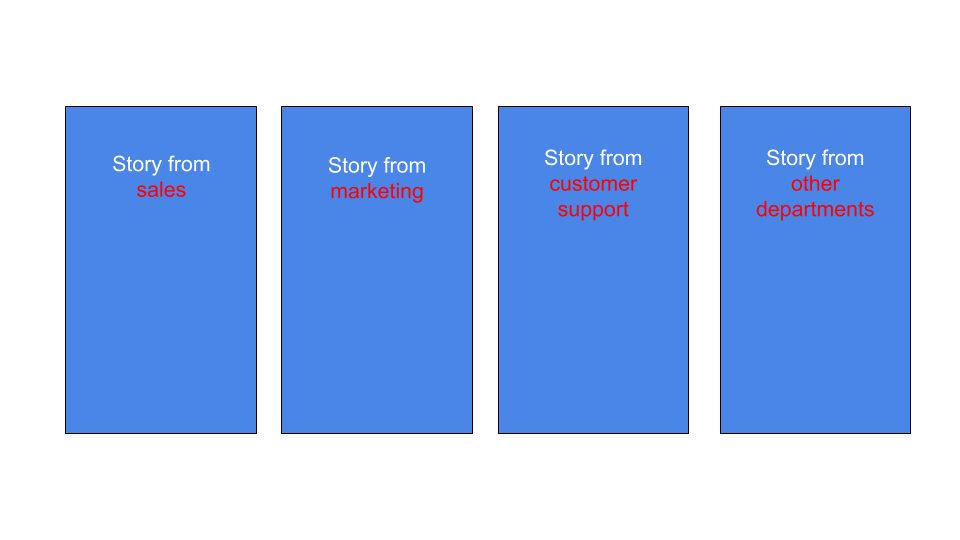
This approach allows you to keep each story hyper-focused on one persona, allowing you to really get into the details for each.
Sales loves this approach because they can select and share the exact story to match the interests of the person or department they’re targeting.
This approach does have some disadvantages, however.
If you’re working with an outside agency to get these studies done, you’ll pay for each individual study—so your costs may go up.
This approach can also get bogged down by the approvals and release loops needed for each study. These take time.
The biggest shortcoming of this approach is that it doesn’t have that one unifying asset that really shows your cross-enterprise implementation success—which is the main goal of sharing your big success story.
Solution #2: Tell one giant story in one unified asset
In this approach, you create one asset that tells the whole story—kit and kaboodle—and fully explores all perspectives in one unified asset.
This could be something like an ebook with a table of contents:
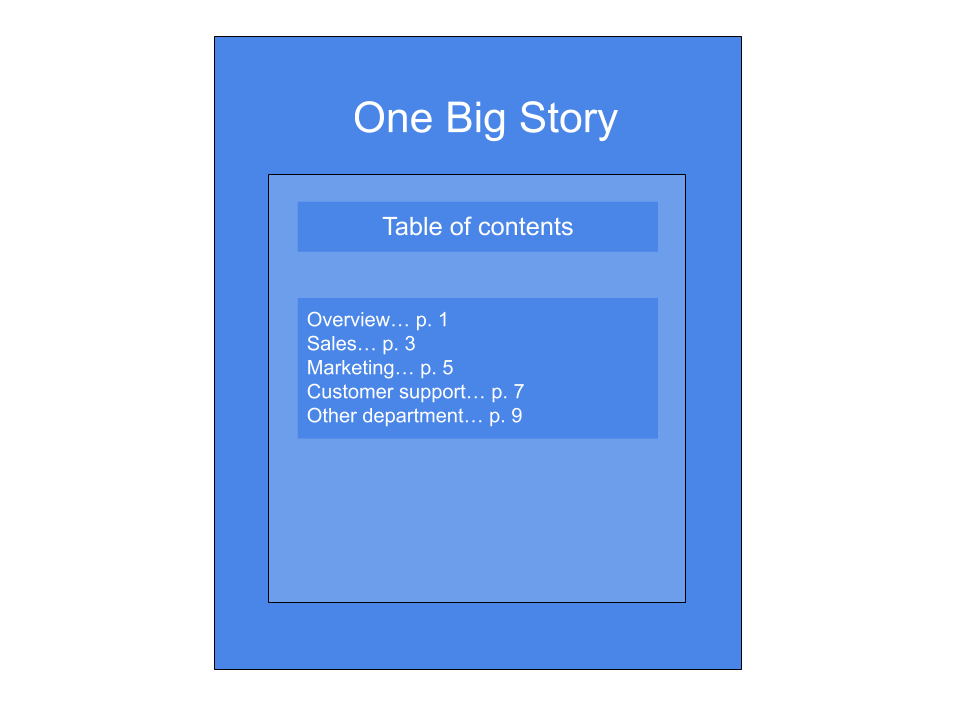
Your target audience will have to use the table of contents or page through the ebook to find the section most relevant to them, which could turn off some readers. The length might also scare some people off.
However, this solution does the best job of incorporating all the personas in a unified asset. Because there’s no limit on length, you have as much room as needed for depth and detail.
Solution #3: Tell a broad story with interactive elements
Here we get more creative in our brainstorming.
In this option, you tell a broad overall story and then link off to smaller interactive assets that tell mini-stories of the different teams involved.
These interactive pieces could be lightboxes, short videos, or a slide deck that shares testimonials or soundbites.
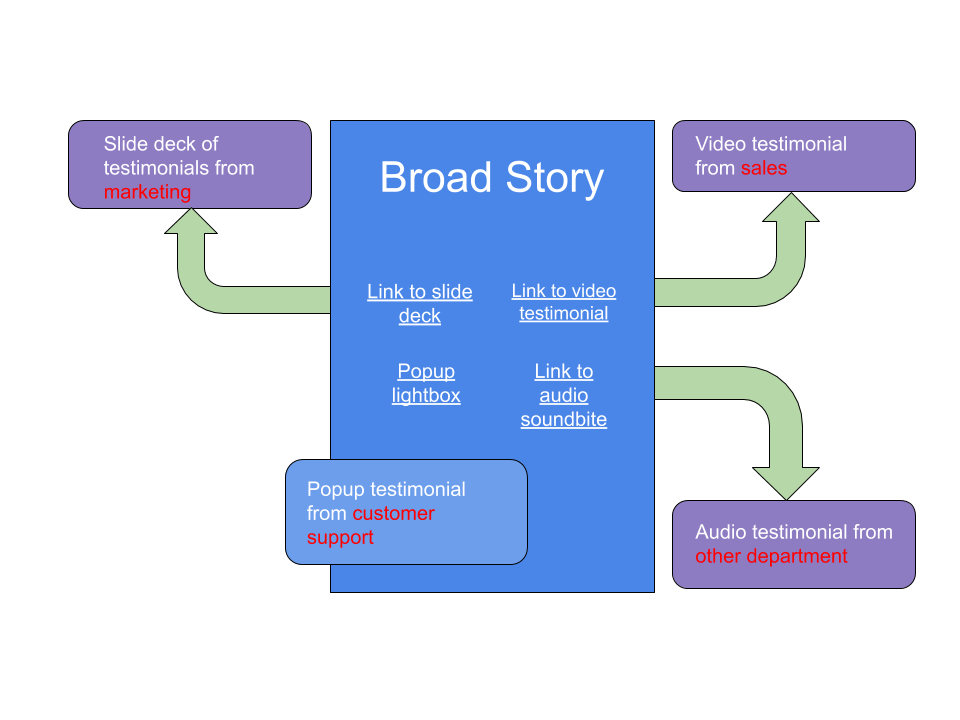
This solution incorporates all the personas, in a limited way, while telling the unified story in one place.
These interactive elements give readers the ability to “choose their own adventure” as they decide which interactive elements to explore.
The downside of this approach is that the main story will necessarily be a bit shallow, and it may be tough to find a good storytelling hook.
Further, creating and deploying the interactive elements will require development assistance, which may be an issue if your SaaS runs lean in that department.
Solution #4: Tell a broad story with links to short Q&A blog posts
A similar approach is to tell a broad story, but instead of using smaller interactive elements to get the perspectives of other participants, you include short question and answer blog post profiles for everyone involved.
This approach still tells a broad unified story in one spot with branches into other areas, but it requires fewer development resources:
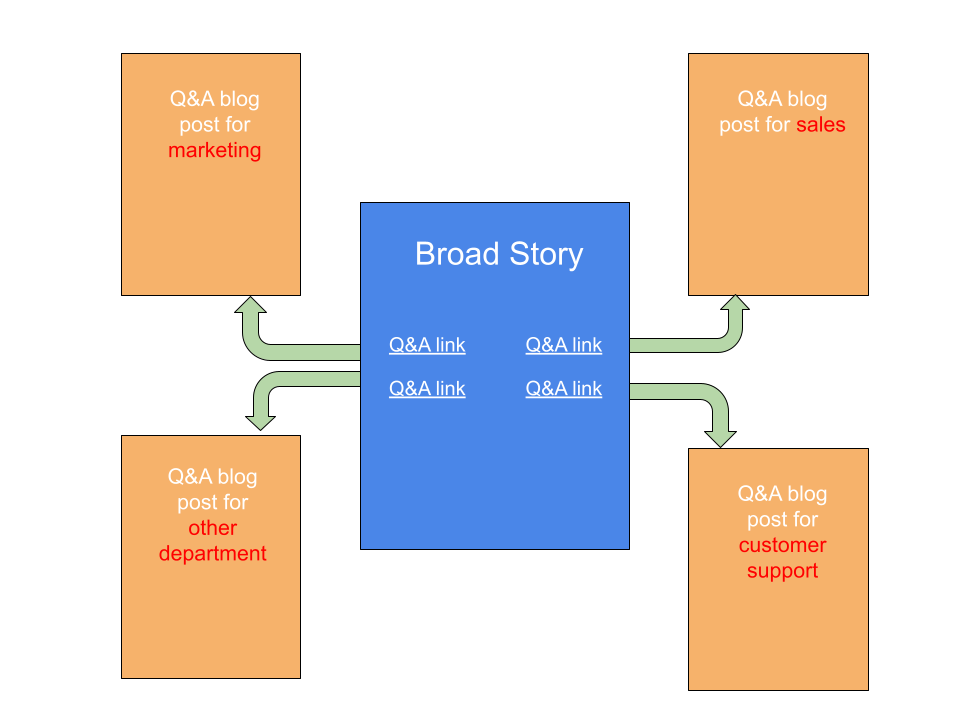
The Q&A blog posts could easily be created from the case study interviews, so no additional participation is needed from interviewees. (As opposed to creating short videos, for example, which would require further involvement.)
Solution #5: Tell a broad story with links to one-sheet slides and Q&A blog posts
This approach adds an additional layer to the above solution.
Here, you tell a broad story but use one-sheet slides to capture the perspectives of all the teams involved.
The one-sheet slides contain links to Q&A blog posts:
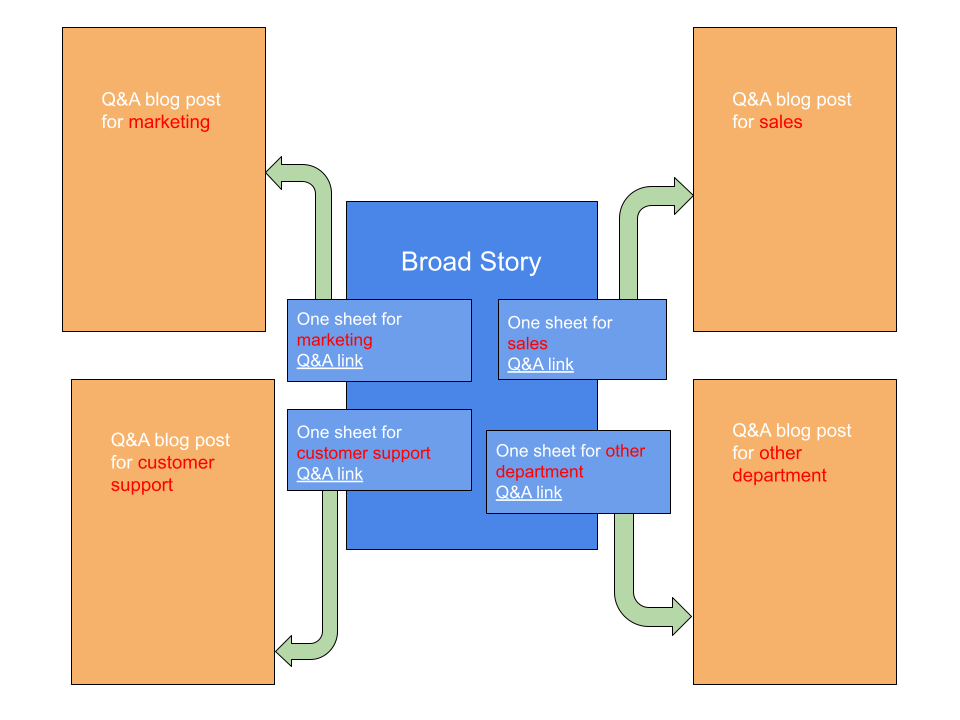
This approach gives a brief glimpse into the perspectives of the other participants (via the one-sheet slides) while also giving readers the option of learning more (via the Q&A blog posts).
The one sheets could include things like:
- A quick summary of the story from that team’s perspective
- A hero quote (the most important thing that participant shared)
- A quick summary of their top three features with a one-sentence rationale. (This could also link to a features page.)
- One to three hero metrics for easy scanning
- A link to a Q&A style blog post if someone wants to explore the entire interview
Here’s a rough draft of what a one sheet might look like:
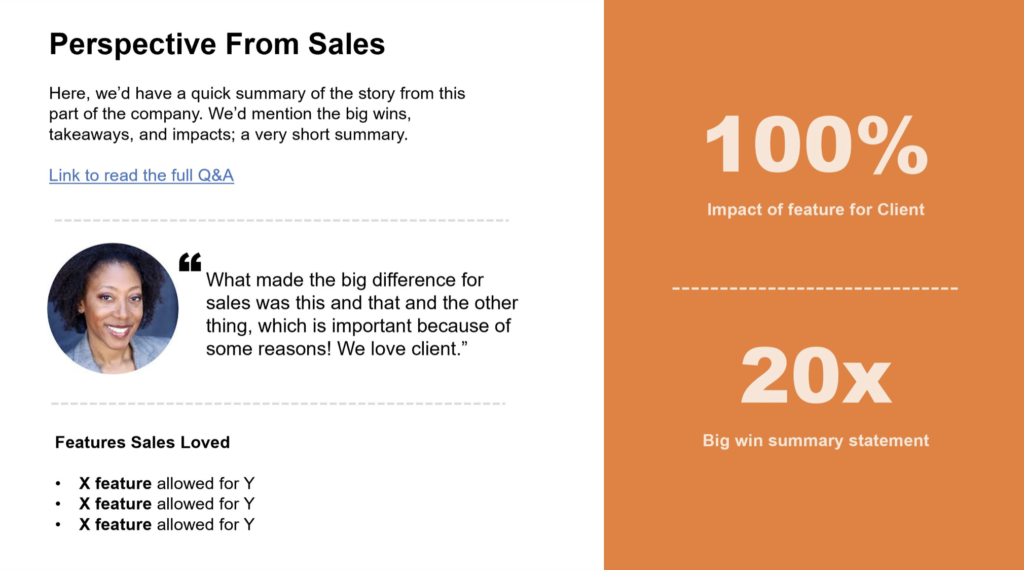
As a side note, these creative solutions are infinitely better than how most companies currently display case studies on their website.
You can do so much more than a thumbnail and PDF!
These solutions take more visual real estate, for sure, but they give readers quick access into the story with the option to push into the full story if they want.
You CAN tell focused and effective cross-enterprise success stories
While cross-functional customer success stories are more complicated to tell, they’re well worth the effort, no matter which solution you choose.
Need help telling your big, complex, cross-enterprise success story?
Contact us to start the conversation.